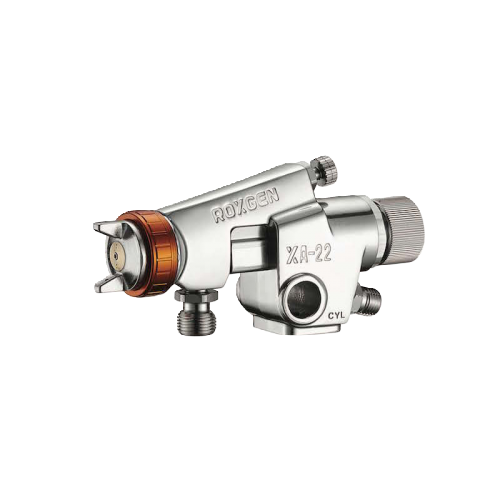How does the ceramic spray gun differ from other types of automatic spray guns?


Ceramic Coating Spray Gun: Key Differences and Industrial Applications
Introduction to Ceramic Coating Spray Guns
A ceramic coating spray gun is a type of automatic spray gun specifically designed for applying ceramic materials. Compared to standard automatic spray guns, it differs in structural design, material handling capabilities, and durability. Its main advantage is the ability to handle high-temperature, high-wear, and abrasive coatings, making it suitable for industrial environments that require high-performance ceramic coatings.
Material Handling: Ceramic vs Standard Spray Guns
Ceramic spray guns are engineered for spraying ceramic powders and ceramic-based coatings, such as alumina (Al₂O₃) and zirconia (ZrO₂). These coatings are commonly used for:
- Thermal barrier coatings (TBCs)
- Wear-resistant layers
- Electrical insulation layers
Standard automatic spray guns are generally used for liquid coatings like paints, varnishes, water-based coatings, or adhesives. They are not designed for abrasive or high-temperature materials and may wear out quickly under such conditions.
Material Handling Comparison Table
| Feature / Aspect | Ceramic Spray Gun | Standard Automatic Spray Gun |
|---|---|---|
| Material Type | Ceramic powders, ceramic-based coatings | Liquid coatings such as paint, varnish, adhesives |
| Common Coating Applications | Thermal barrier coatings, wear-resistant layers, electrical insulation | Automotive paint, furniture, electronics coatings |
| Abrasiveness Handling | High – designed for abrasive materials | Low – not suitable for abrasive materials |
| Temperature Resistance | High – can handle high-temperature materials | Low to moderate – suited for room temperature coatings |
| Durability under Stress | Excellent – ceramic, carbide, or special alloy components | Moderate – aluminum or stainless steel components |
| Industrial Suitability | Aerospace, power generation, automotive engines, heavy machinery | Automotive finishing, furniture, electronics |
Structural Design and Durability
The internal components of a ceramic coating spray gun, such as nozzles, needles, and spray tips, are typically made from ceramic, carbide, or specialized alloys, providing excellent wear and corrosion resistance. This allows the gun to operate reliably under high temperatures and abrasive conditions.
In contrast, standard automatic spray guns are made from aluminum alloys or stainless steel, suitable for low-abrasion spraying tasks. Using them for ceramic coatings or harsh environments can result in rapid wear, clogging, and inconsistent performance.
Industrial Applications of Ceramic Coating Spray Guns
Ceramic spray guns are widely used in industries requiring high-performance, wear-resistant, and heat-resistant coatings. Below is a detailed overview of key applications.
Aerospace Components
In the aerospace industry, components such as turbine blades, engine casings, and exhaust nozzles must withstand extreme temperatures and corrosive environments. Using a ceramic coating spray gun allows manufacturers to apply thermal barrier coatings, which:
- Improve heat resistance and reduce thermal fatigue
- Protect metal surfaces from oxidation and corrosion
- Extend the service life of critical engine parts
Ceramic coatings applied through plasma spraying or HVOF spraying are essential for ensuring engine efficiency and reliability in commercial and military aircraft.
Power Generation Turbines
Power generation turbines, including gas and steam turbines, operate under high temperatures and mechanical stress. A ceramic spray gun enables the application of wear-resistant and heat-resistant coatings on:
- Turbine blades
- Rotor components
- Combustion chambers
These coatings enhance thermal efficiency, reduce maintenance frequency, and protect against erosion and oxidation, which are common in power plant environments.
Automotive Engine Parts
In the automotive sector, engine components such as pistons, cylinder heads, turbochargers, and valves benefit from ceramic coatings for improved wear resistance and heat insulation. Applying coatings with a ceramic coating spray gun:
- Reduces engine friction and wear
- Improves fuel efficiency and engine performance
- Extends the lifespan of parts exposed to high temperatures
Thermal spray coatings also help in emission control by protecting components in high-temperature exhaust systems.
Heavy Machinery Manufacturing
Heavy machinery used in construction, mining, and industrial applications experiences high mechanical stress, abrasive environments, and heat exposure. Ceramic coatings applied via ceramic spray guns provide:
- Wear-resistant surfaces for gears, shafts, and rollers
- Corrosion protection for equipment exposed to chemicals or moisture
- Thermal protection for parts subjected to friction or heat
These coatings increase equipment durability, reduce downtime, and improve overall operational efficiency in heavy machinery applications.
Cost, Maintenance, and Long-Term Performance
Although ceramic coating spray guns have a higher initial cost and require careful operation and maintenance, they offer superior durability, coating quality, and long-term operational efficiency. Choosing the right spray gun should consider:
- Material properties
- Application requirements
- Production conditions
This ensures optimal performance, minimal downtime, and cost-effective operations.
Conclusion: Selecting the Right Spray Gun
For projects involving high-temperature, wear-resistant, or abrasive ceramic coatings, a ceramic coating spray gun is the most reliable option. For applications involving non-abrasive liquid coatings, a standard automatic spray gun may suffice. Understanding the differences in design, material handling, durability, and industrial suitability is key to achieving consistent results and maximum operational efficiency.




